Exhibition March – June 2018
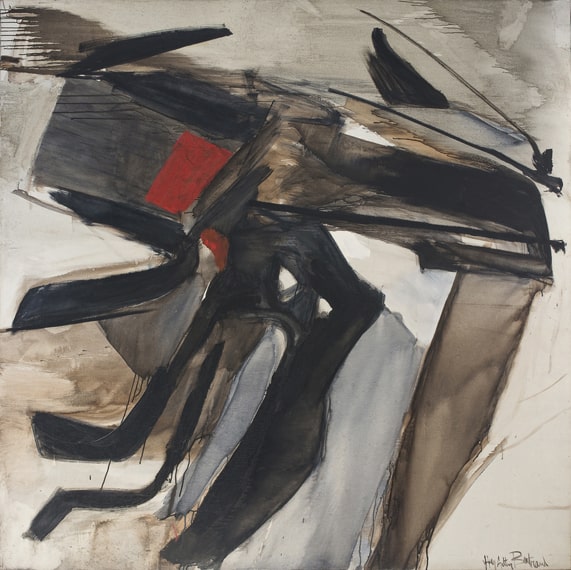
A rare woman painter of Lyrical Abstraction, Huguette Arthur Bertrand brilliantly found her place in the essentially male art world of the Post-War period.
A volcano, her fiery, passionate, gestures seduced me immediately and it is an honour to present her work thanks to the unconditional support of her nephew Philippe Bertrand!
Diane de Polignac

Obliquely and Across
Dominique Gagneux
Chief Curator of Heritage
This unusual title of a painting1 by Huguette Arthur Bertrand could provide a good summary of her work’s place in the Post-War artistic landscape. After arriving in Paris in 1946, she became one of the few women to join the ranks of young artists who were practicing a form of abstraction that was at first geometrical and then became more spontaneous, adhering to an artistic movement that would be called, according to attempts at clarification by critics, “lyrical, gestural, informal or tachist”.
After attending the Grande Chaumière, training and a first solo exhibition in Prague in 1947 where she met the painter Joseph Sima, Huguette Arthur Bertrand discovered Parisian life in the quarters of Montparnasse and Saint-Germain des Prés, and became friendly with publishers such as Jean Deyrolle and Jean Dewasne, and according to Michel Ragon,2 attended open Saturdays at the studio of Jean-Michel Atlan with Marcelle Loubchansky. She must have lived this period as if in a dream, participating in the effervescence of artist life whose intense activity crystallised around theoretical debates between figuration and non-figuration, but also between geometric and gestural abstraction. Practiced by Wols, Hans Hartung, Georges Mathieu and Gérard Schneider, this form of art, which abandoned the object for spontaneity and subjective impulse, was supported by critics and galleries that organized exhibitions establishing this new way of being in the world.
Huguette Arthur Bertrand exhibited at abstract art Salons (starting in 1949 at the Salon de Mai, in 1950 at the Salon des Réalités Nouvelles, at the Salon d’Octobre organized by Charles Estienne). She participated for two consecutive years at the exhibitions of the “Mains éblouies”, organized by Aimé Maeght in his gallery between 1947 and 1950 and devoted to young abstract artists.3 One of the members of this group, Serge Rezvani, remembered in his publication Le Testament Amoureux, that “to get out of the rut of taste was lively, exhilarating; painting spoke its language, was a language of action”4
Extolling the radical values of this pure and gestural painting, Huguette Arthur Bertrand enjoyed the support of critics such as Julien Alvard who prefaced her solo exhibition in May 1951 at Henriette Niépce’s gallery.
The following year, she became one of the artists of the gallery that Jean-Robert Arnaud opened with John Franklin Koenig on the Rue du Four, remaining until 1959. This essential venue promoted the work of the American artists, Jack Youngerman and Ellsworth Kelly, exhibited Jean Tinguely and Denise René, and served as the base for the launch of the journal Cimaise on which the critics Michel Ragon and Roger Van Gindertael, Julien Alvard and Pierre Restany worked together, as well as Dore Ashton from New York.
Huguette Arthur Bertrand gradually became a major figure of the second generation of lyrical abstraction. She won the Prix Fénéon, was among the “Sixteen painters of the new Paris School” of the affordable collection of the Musée de Poche5 and held solo exhibitions abroad.
During this decade, her art became more precise. If in the early paintings, the colours reduced to a range of ochres and dark greens owed much to those of Cubism – from where so many abstract artists began – Huguette Arthur Bertrand very quickly developed a practice of the dynamic gesture, counterbalanced, for the sake of balance, by large coloured shapes. These black, blue, yellow and red surfaces that give structure to the composition by the precision of their limits, are animated by the presence of very graphic lines. Whether they are organized vertically or horizontally, evoking the weft of a weaving, or streak the composition with greater suppleness, these parallels give the canvas a visual mobility and reveal the ambiguous character of the painted space that is both static and mobile.6 These are the features that characterise the work of Huguette Arthur Bertrand during this period, which were analysed so well by Van Gindertael in 1955 as a rhythmic and cadenced leitmotiv.
Starting in 1960, her paintings show increased pleasure in acting on the canvas and recreating the energy of the gesture. “These are things that fly, abstract objects that make faces, movements that cut into space”, Huguette Arthur Bertrand said to the critic Michel Ragon in1962.7 Painting became darker, more broadly traced, against a background of ochre or grey applied in transparent layers and highlighted with a few touches of a bright colour. Often starting from a very brown or black centre, the gesture erupted furiously, “between rigour and freedom, evolving in frustrated desires”.8 This vehemence is also expressed in the titles: Déferlant, Torrent, Cela qui gronde, Ramassé écartelé, Emportée.
In Joseph Sima’s very poetic painting, the search for unity of material through light is constant. It is not conceived, in his own words, “like a mysterious fluid illuminating the objects, but as a force creating the existence of the objects”. 9 The controlled spontaneity sought by Sima, like the transposition of luminous sensations onto the canvas, certainly influenced Huguette Arthur Bertrand, in a way that is paradoxically felt in her late works. The use of essence that dilutes the colours allows a play of subtle nebulous forms, dominated by earthy colours, applied in a chastened gesture that is always dynamic. The sensation of space is more diffuse, the calligraphy more elliptical.
Conscious of the need not to hem herself in, not to repeata manner that was already done, Huguette Arthur Bertrand never submitted to an unchangeable system. In the early 1970s she found in the practice of tapestry a possibility for renewal that allowed her to work on the scale of a wall, like in monumental painting. However, she did not just return to family tradition or continue the renewal of tapestry that had been begun by Jean Lurçat.
Even if, most often, she transposed her paintings and watercolours into tapestries in the classical manner, the freedom she retained at the time of weaving, with respect to the model, the use of relief, the abolition of the difference between obverse and reverse illustrate clearly this desire to form a contemporary vision, between painting and sculpture, between immobility and movement, between fine art and craft.
It may then be relevant to assess the work of Huguette Arthur Bertrand not only by analysing her aesthetic career, but also by placing it in a sociological context where feminism questioned the traditional position of the woman in society, at a time when the art critic Aline Dallier-Popper was developing a historiography of the relationship of women to creation in textile by inventing the term “new Penelopes” in 1976. This reading could be validated retrospectively by a critical analysis of the television interview given by the artist in 1962 to Michel Ragon. When he describes “painting that does not appear to be feminine at all; painting that is even muscular, strong painting, painting of a dynamism that appears masculine […]”, she reveals her obligation to “take on a man’s life”10 to practice her art. Could this assimilation of gestural painting with “masculinist” art, from which the abstract expressionist painters Lee Krasner and Helen Frankenthaler have also suffered, have contributed to overshadowing the true place of Huguette Arthur Bertrand in modernity of the second half of the 20th century?

1 – Obliquement et à travers, 1964, oil on canvas, 80 x 65 cm, private collection.
2 – Michel Ragon, D’une berge à l’autre, Albin Michel, 1997, p.152.
3 – In 1949, the group of the “Mains éblouis” comprised, alongside Huguette Arthur Bertrand, Serge Rezvani, Signovert, Dmitrienko, Arnal, Eduardo Paolozzi, Pablo Palazuelo, Nejad, Dany Beauregard, Bernard Dufour, Georges Koskas and George Collignon. The text of n°22 of Derrière le miroir is by Pierre Descargues.
For the exhibition of October 1950 which brought together, amongst others, Pierre Alechinsky, Arnal, de Brunhoff, Chillida, Goetz, Palazuelo and Youngermann, the texts of n°32 were written by Jean Cassou and Michel Ragon.
4 – Cited in Natalie Adamson Painting, Politics and the Struggle for the Ecole de Paris, 1944-1964, Ashgate, 2009 note 54.
5 – Hubert Juin, Seize peintres de la Jeune École de Paris – Nallard,
Moser, Sugaï, Corneille, Chelimsky, Gillet, Doucet, Arnal, Alechinsky,
Lapoujade, Martin Barré, Camille, Bertini, Maryan, Levée, H.A. Bertrand, Coll. Le Musée de Poche, publisher: Georges Fall, 1956.
6 – Gérard Xuriguera, Les Années 1950, Arted, 1984.
7 – RTF / ORTF, Jean Marie Drot and Christian Heidsieck, « L’art et les hommes », L’oeil d’un critique avec Michel Ragon, programme of 4 February 1962.
8 – L’OEil, 1993, Numbers 448 to 452, p. 75.
9 – Josef Síma, Musée d’art moderne de la Ville de Paris, Parismusées, 1992, p.23.
10 – RTF/ORTF, ibid.
WORKS
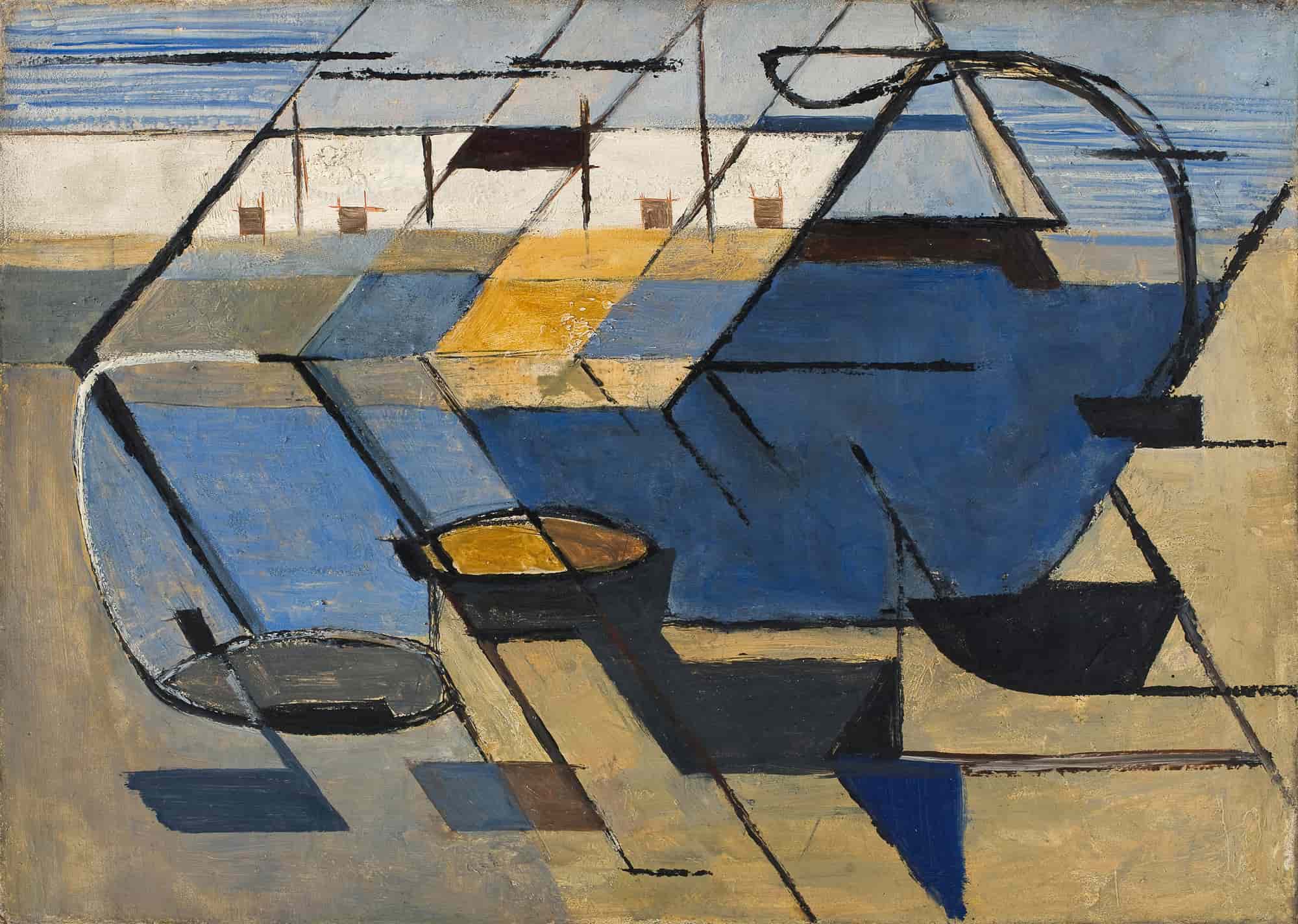
SANS TITRE, 1949
Oil on canvas
38,5 x 55,5 cm. – 15.2 x 21.8 in.
Signed and dated on the reverse

SANS TITRE, 1951
Oil on canvas
46 x 65 cm. – 18.5 x 26 in.
Signed and dated on the reverse
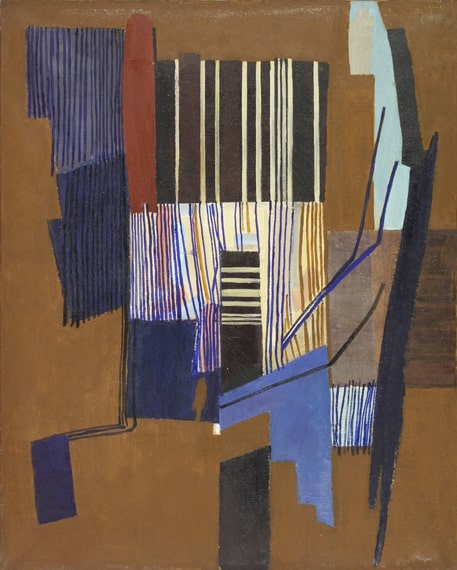
Composition, 1955 ca.
Huile sur toile, 92 x 73 cm.
Collection du Musée national des beaux‑arts du Québec,
Legs Lucille Gardiner Larivière
© Succession Huguette-Arthur Bertrand / SODRAC
Crédit photo : MNBAQ, Jean-Guy Kérouac
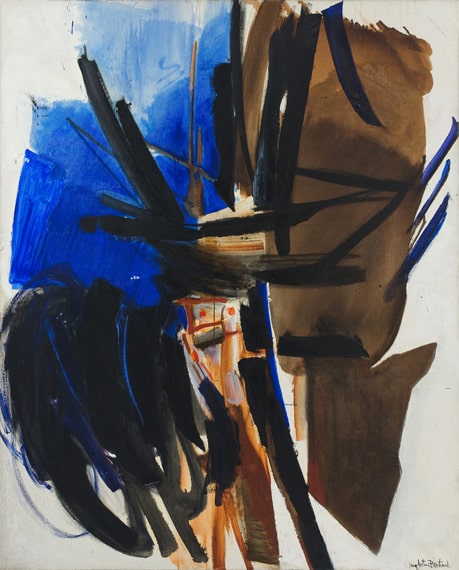
RAZ DE MARREE, ANNEES 1960 – 1960’s
Oil on canvas
162 x 130 cm. – 63.8 x 51.2 in.
Signed lower right; titled on the reverse
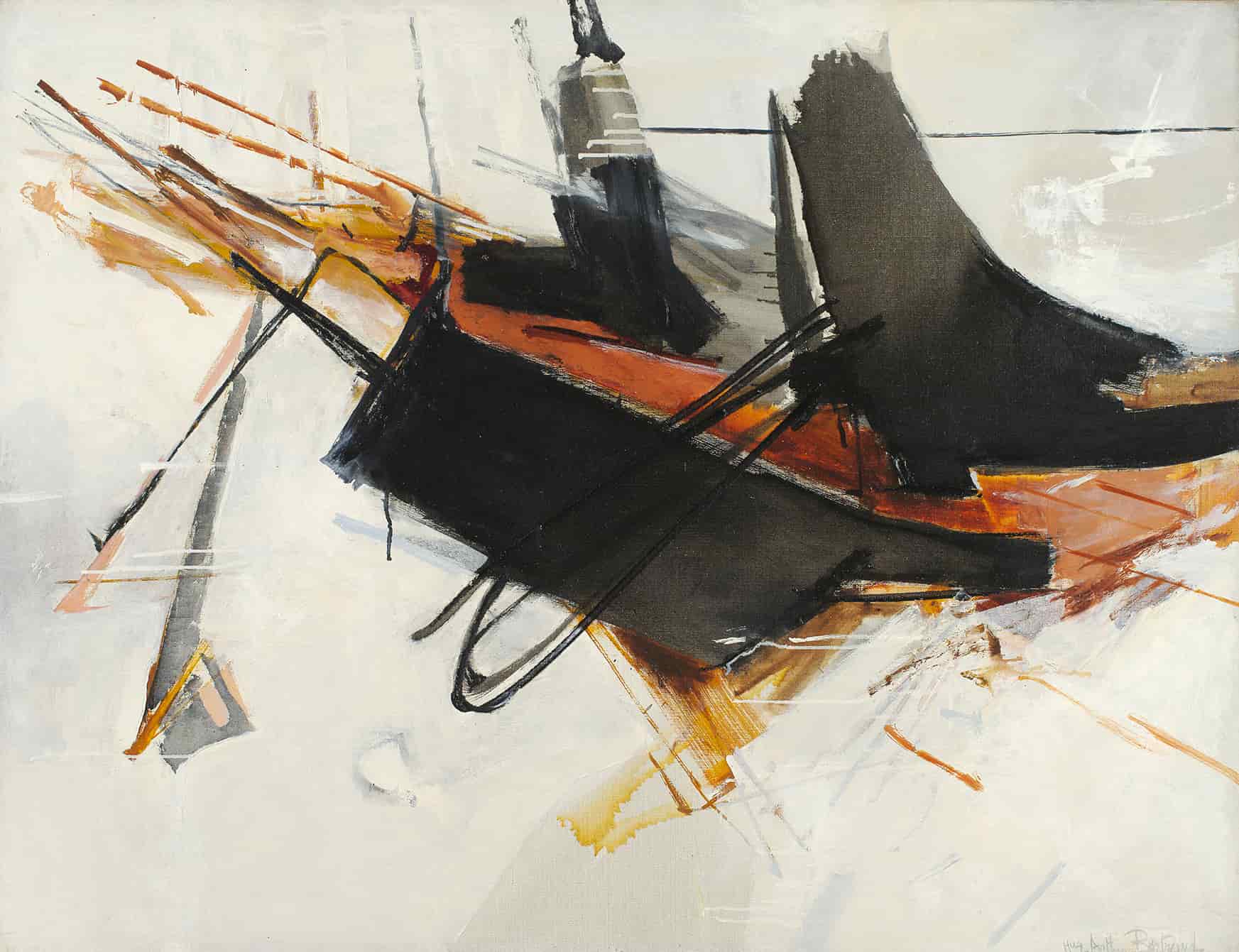
PIRADOR, 1961
Oil on canvas
89 x 116 cm. – 35.5 x 46 in.
Signed lower right; signed, titled and dated on the reverse
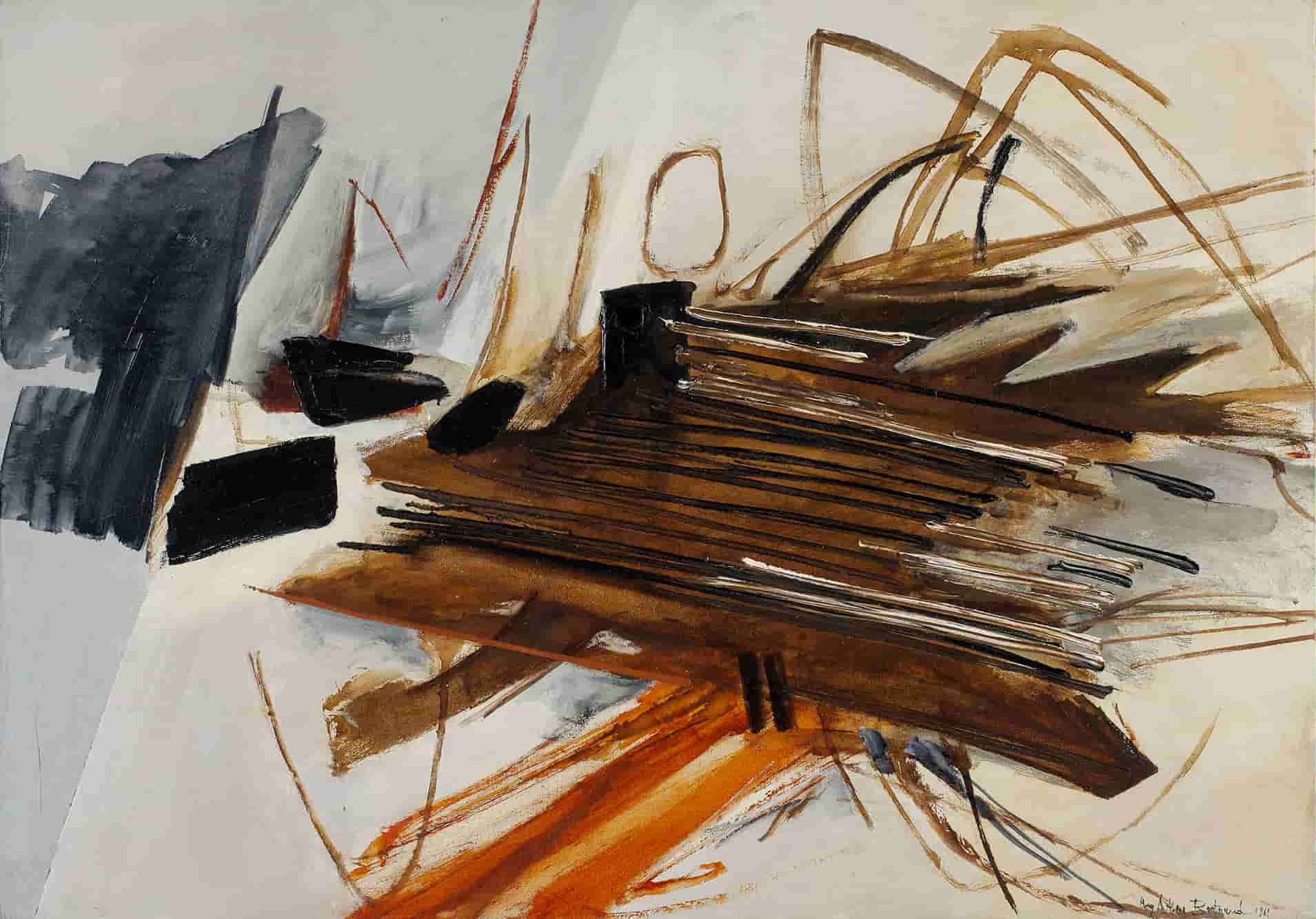
LOHENGRIN, 1961
Oil on canvas
81 x 116 cm. – 32 x 46 in.
Signed and dated lower right; signed, titled and dated on the reverse

OULAN BATOR, ANNEES 1960 – 1960’s
Oil on canvas
162 x 130 cm. – 64.5 x 52 in.
Signed lower right; titled on the reverse
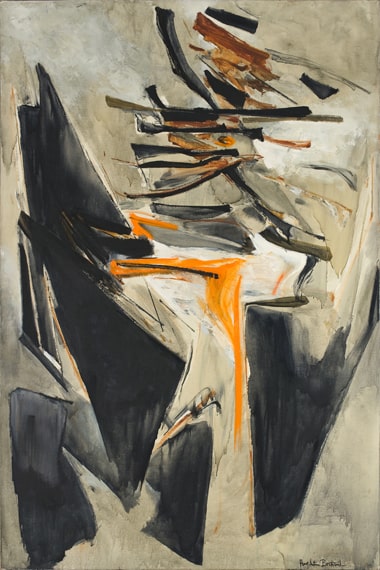
AMERS, 1964
Oil on canvas
195 x 130 cm. – 78 x 52 in.
Signed lower right; titled, signed and dated on the reverse

Les ajoncs, 1961
Huile sur toile, 195 x 114 cm.
Centre Pompidou, MNAM-CCI

GEVAUDAN, 1966 ca .
Oil on canvas
200 x 200 cm. – 78.7 x 78.7 in.
Signed lower right; titled and signed on the reverse

Écume noire, 1966
Huile sur toile, 100 x 100 cm.
Musée d’Art moderne de la Ville de Paris

CELA QUI GRONDE, 1967
Oil on canvas
130 x 162 cm. – 52 x 64.5 in.
Signed lower right; titled and dated on the reverse
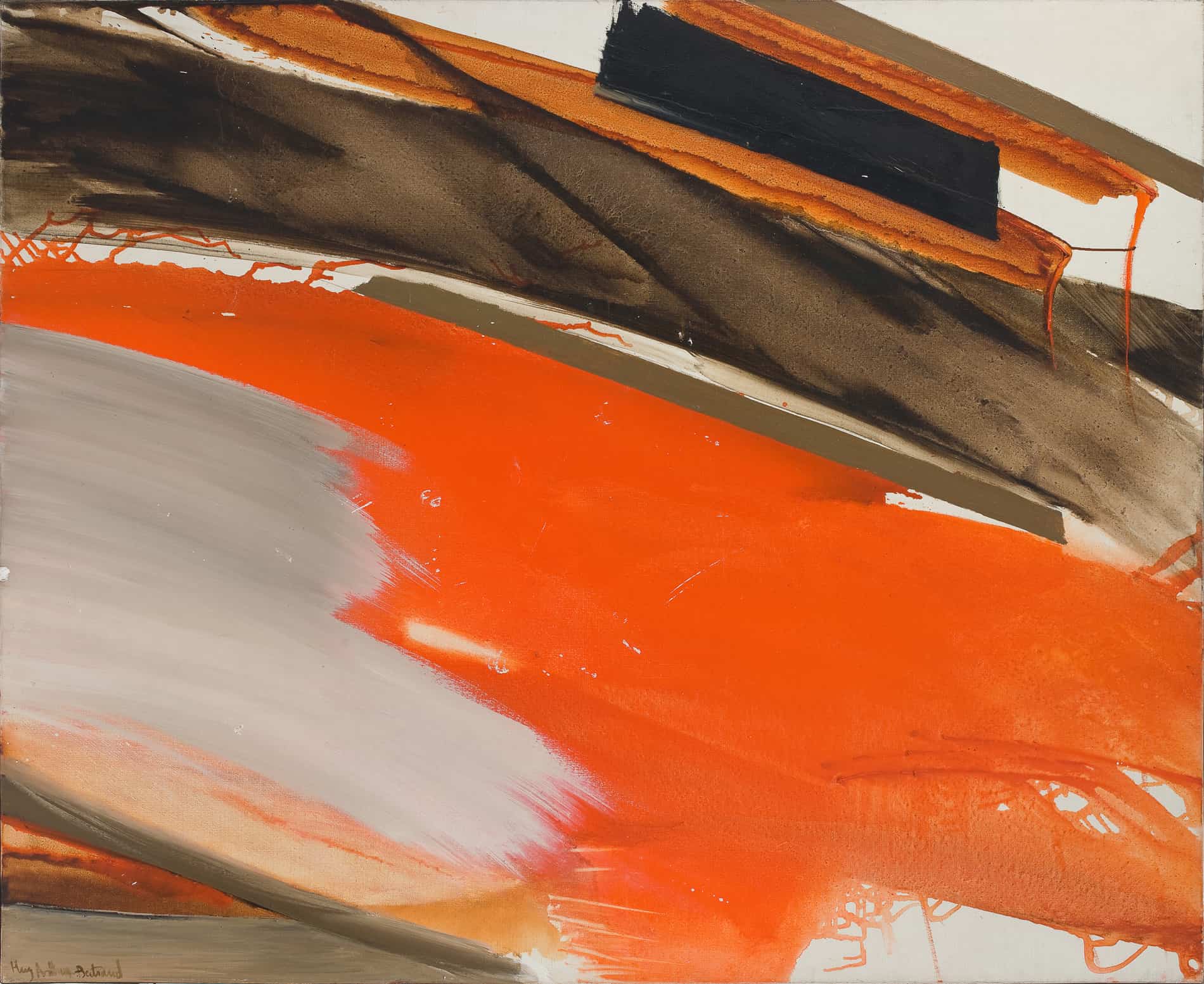
DEFERLANT ROUGE ET GRIS SUR BRUN, ANNEES 1970 – 1970’s
Oil on canvas
130 x 162 cm. – 52 x 64.5 in.
Signed lower left; titled and signed on the reverse

TORRENT, 1980 CA
Oil on canvas
195 x 130 cm. – 78 x 52 in.
Signed lower right; titled and signed on the reverse
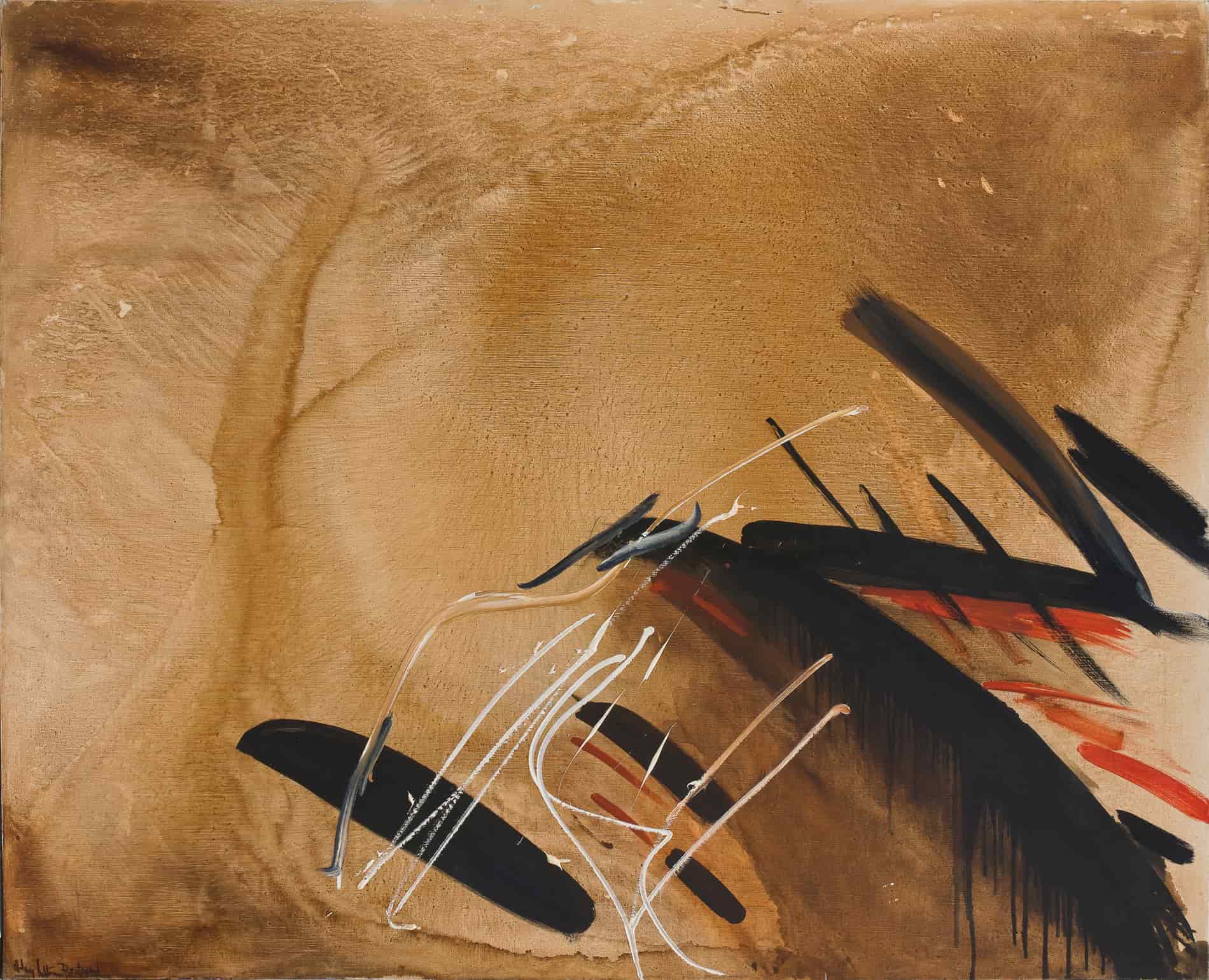
REMOUS, 1984-1986
Oil on canvas
130 x 162 cm. – 52 x 64.5 in.
Signed lower left; titled, signed and dated on the reverse
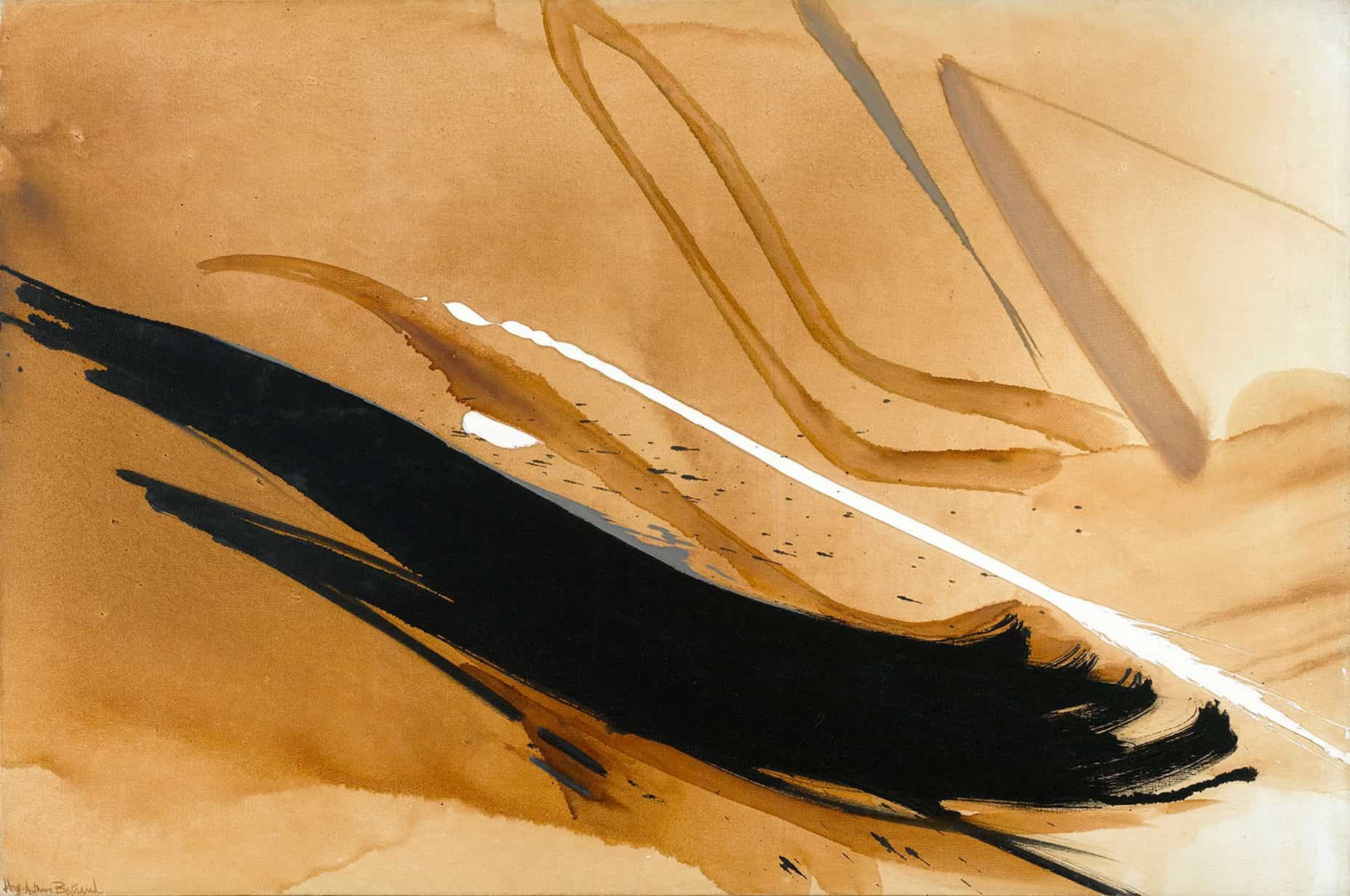
L’AMANT CACHALOT, ANNEES 1980 – 1980’s
Oil on canvas
96 x 141 cm. – 37.8 x 55.5 in.
Signed lower left; titled and signed on the reverse

VOIE DIRECTE, 1992
Oil on canvas
162 x 130 cm. – 64.5 x 52 in.
Signed lower right; signed, titled and dated on the reverse
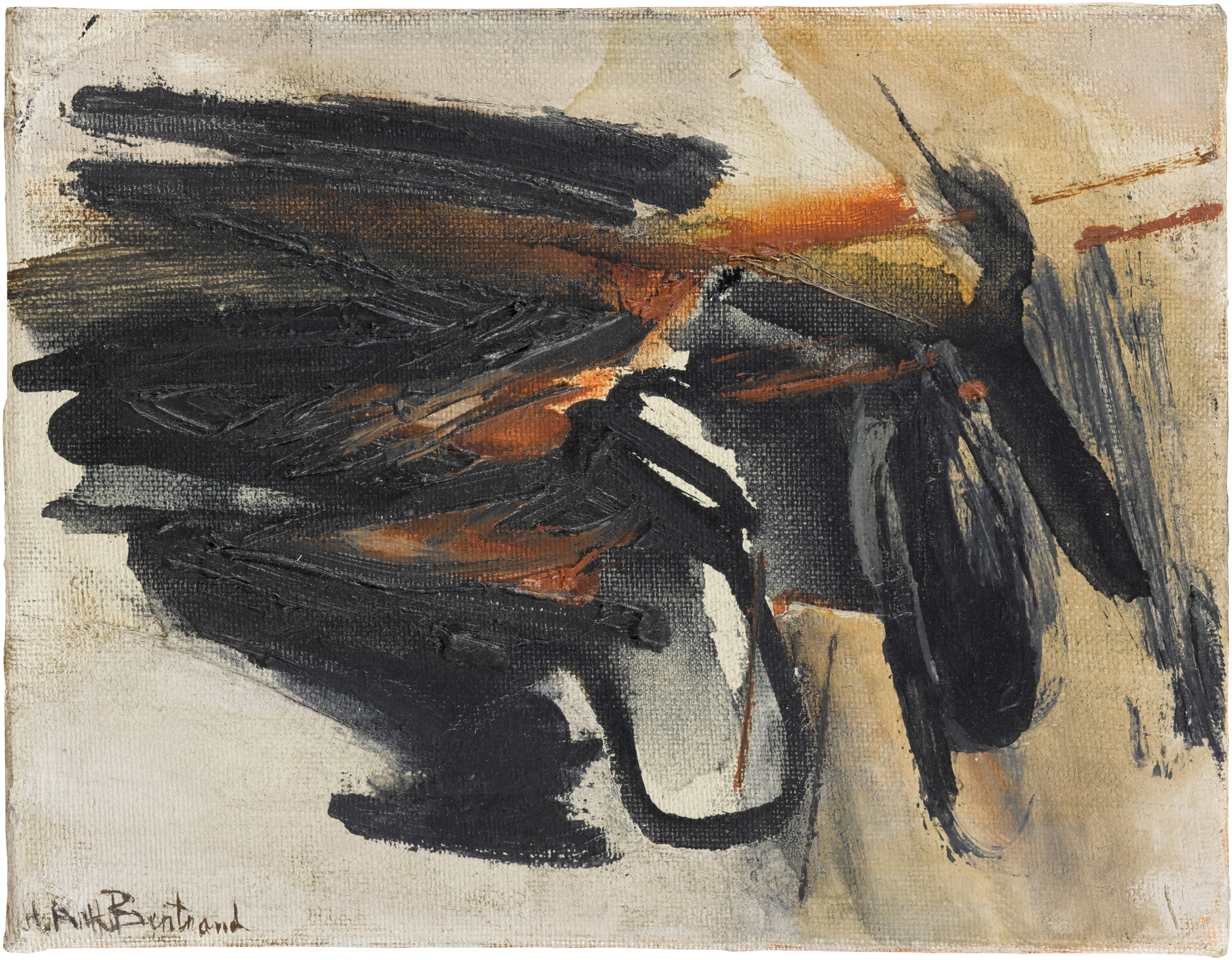
SANS TITRE, ANNEES 1960 – 1960’s
Oil on canvas
14 x 18 cm. – 5.51 x 7.09 in.
Signed lower left

SANS TITRE, 1963
Oil on canvas
18 x 14 cm. – 7.09 x 5.51 in.
Signed lower left; dated on the reverse
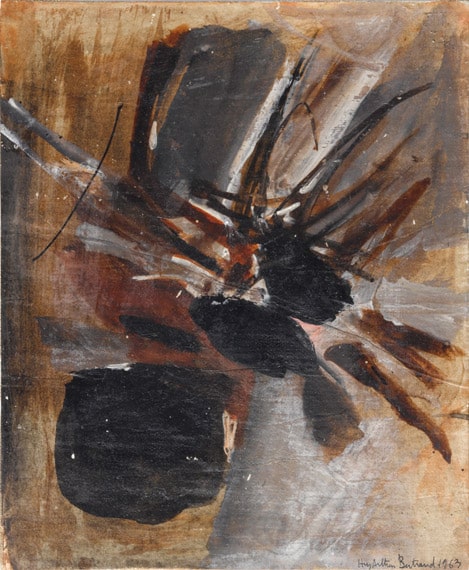
SANS TITRE, 1963
Oil on paper laid down on canvas
21 x 18 cm. – 8.27 x 7.09 in.
Signed and dated lower right

SANS TITRE, 1963
Gouache on paper
20,5 x 21,5 cm. – 8.07 x 8.46 in.
Signed and dated lower right
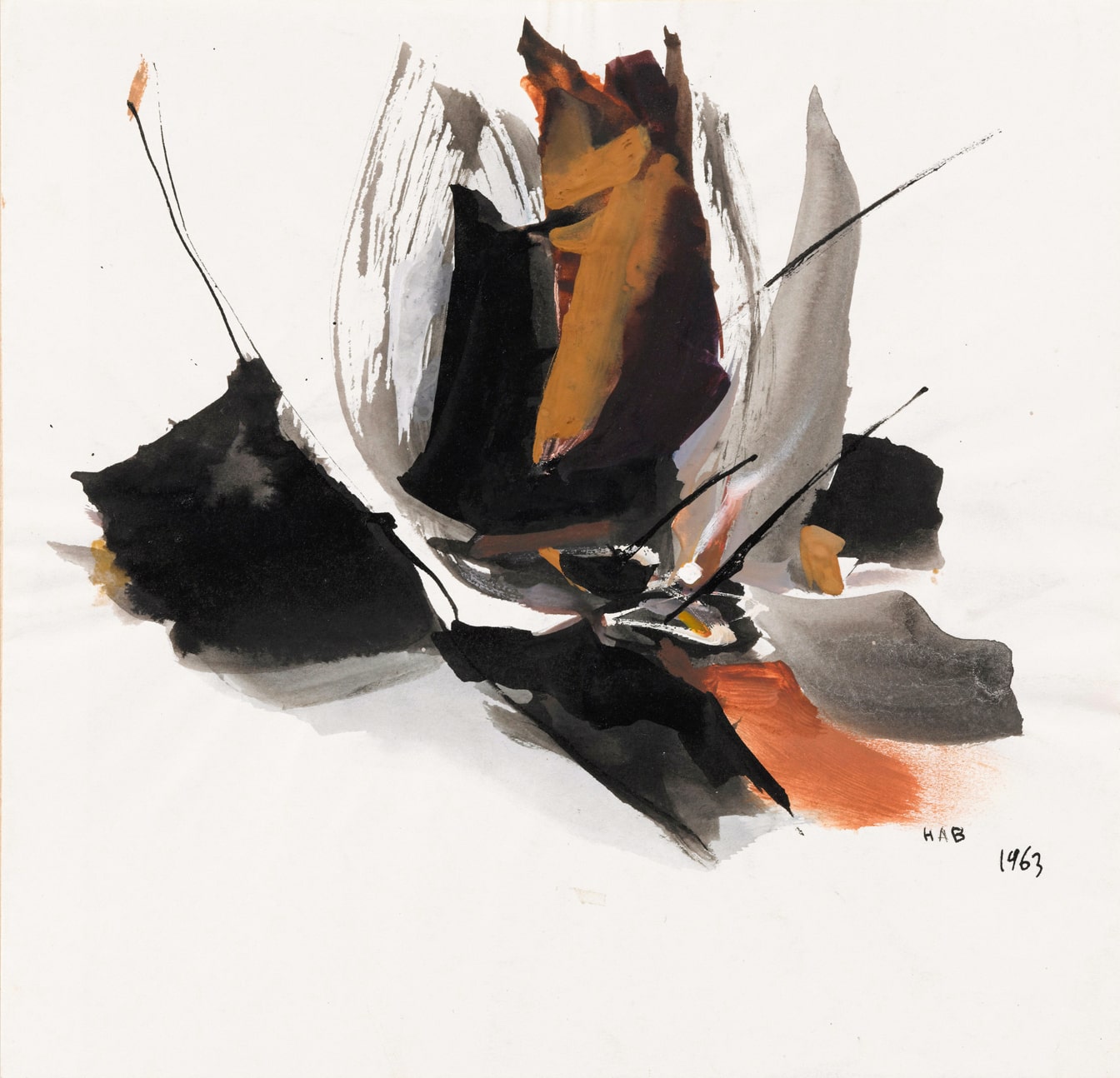
SANS TITRE, 1963
Gouache on paper
20,6 x 21,5 cm. – 8.11 x 8.46 in.
Signed and dated lower right

SANS TITRE, 1960 CA
Gouache on paper
22 x 17 cm. – 8.66 x 6.69 in.
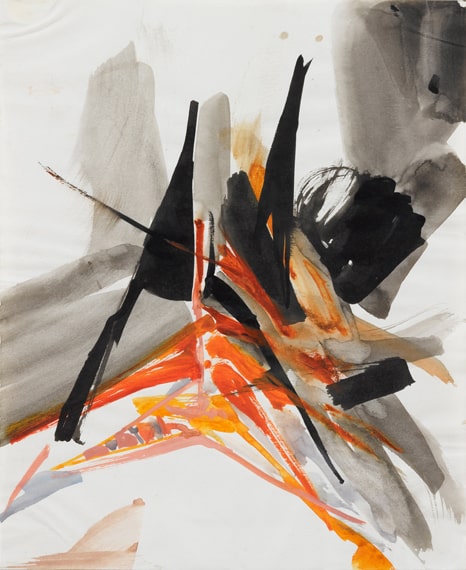
SANS TITRE, 1960 CA
Gouache on paper
22 x 17 cm. – 8.66 x 6.69 in.
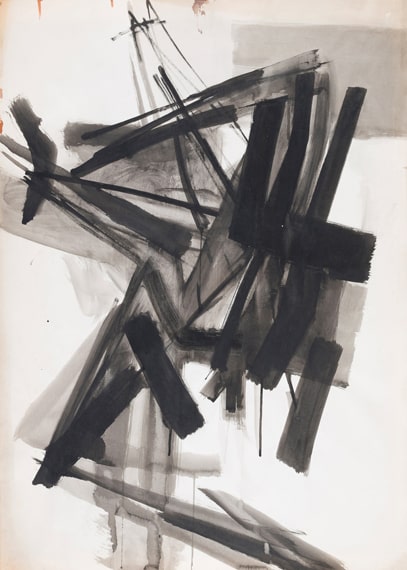
SANS TITRE, 1959 CA
Ink on paper
105 x 76 cm. – 41.3 x 29.9 in.
Signed and artist studio stamp on the reverse
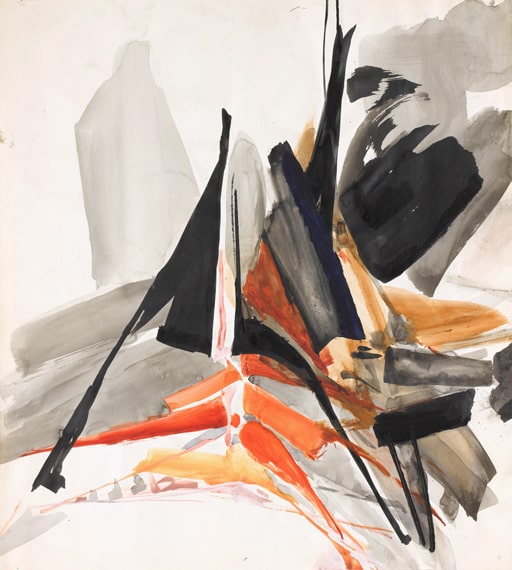
SANS TITRE, 1960 CA
Gouache on paper
80 x 72 cm. – 31.5 x 28.35 in.
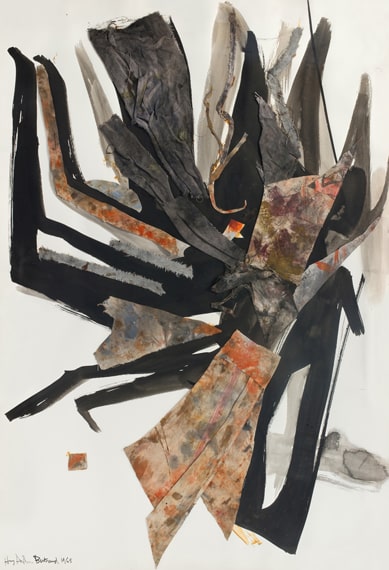
GRAND COLLAGE, 1960 CA
Gouache and collage on paper
110 x 75 cm. – 43.3 x 29.5 in.
Signed and dated lower left
BIOGRAPHY
D’ascendance méridionale et stéphanoise, Huguette Arthur Bertrand naît en 1920 à Écouen, près de Paris. Elle s’éteint à Paris en 2005.
1947 – Première exposition personnelle à Prague
1949 – Participe à :
Les Mains Eblouies, Galerie Maeght, Paris
Salon de Mai, Paris. Elle y exposera jusqu’à la fin des années 80
1950 – Participe à :
Les Mains Eblouies, Galerie Maeght, Paris ; commissaire : Michel Ragon
1951 – Première exposition personnelle en France :
Galerie Niepce, Paris
1952 – Exposition personnelle :
Galerie Arnaud, Paris
Participe à :
Salon d’Octobre, Paris
Premio Bolzano, Bolzano (Italie)
Exposition de groupe, Munich (Allemagne)
1953 – Exposition personnelle :
Galerie Arnaud, Paris
Participe à :
Salon d’Octobre, Paris
1954 – Expositions personnelles :
Galerie Arnaud, Paris (mars)
Galerie Arnaud, Paris (novembre)
Participe à :
Wiener Secession, Vienne (Autriche)
Divergences 2, Galerie Arnaud, Paris
1955 – Expositions personnelles :
Galerie Arnaud, Paris
Galerie Saint-Laurent, Bruxelles
Participation à :
Divergences 3, Galerie Arnaud, Paris et à Knokke-le-Zoute (Belgique)
Jeune peinture française, à La Havane (Cuba) et en Allemagne
Der Kreis, Vienne (Autriche)
Réhabilitation de la gouache, Galerie Arnaud, Paris
Exposition de groupe, Galerie Kleber, Paris
Salon d’Automne, Lyon (France)
Salon des Réalités Nouvelles, Paris – elle y exposera jusqu’aux années 1990
Elle reçoit le célèbre Prix FENEON
1956 – Expositions personnelles :
Galerie Arnaud, Paris
Meltzer Gallery, New York
Galerie Saint-Laurent, Bruxelles
Galerie L’entr’acte, Lausanne (Suisse)
Participe à :
Divergences 4, Galerie Arnaud, Paris, aux Stedelijk Museum d’Amsterdam et de Schiedam (Pays-Bas)
Salon Comparaisons, Paris
Le petit format, Galerie La Roue, Paris
Exposition de groupe, Musée d’Amiens
Cinq jeunes français, Galerie Birch, Copenhague
Festival de l’Art d’avant-garde, Unité Le Corbusier, Marseille
L’Aventure de l’Art Abstrait, par Michel Ragon, Galerie Arnaud, Paris puis à Angers
1957 – Expositions personnelles :
Galerie Arnaud, Paris
Palais des Beaux-Arts, Bruxelles
Galerie Grange, Lyon (France)
Participe à :
Divergences 5, Cité radieuse Le Corbusier, Nantes-Rezé ; Galerie Arnaud, Paris
puis au Micro-Salon d’avril, Galerie Iris Clerc, Paris puis Galerie Apollinaire, Milan
Biennale 57, Pavillon de Marsan, Paris
Analogies, organisé par Olivier Le Corneur, Galerie Arnaud, Paris
Abstraction et Figuration, Galerie Hélène Legendre, Paris
Collages, Galerie Hélène Legendre, Paris
Jeune École de Paris, Galerie 93, Paris
Ouvertures sur le Futur, Galerie Kamer, Paris
Biennale de Menton, Menton (France)
Premio «Lissone», Milan (Italie)
Biennale de Turin (Italie)
Dialogue Franco-Allemand, Galerie Inge Allers, Mannheim (Allemagne)
Triennale de l’art français, Musée des Arts Décoratifs, Paris
Festival de l’art d’avant-garde, Berlin 50 ans de peinture abstraite, présenté par Michel Seuphor, à la Galerie Creuze, Paris
North and south americans and Europeans, Meltzer Gallery, New York
New talents in Europe, University of Alabama (U.S.A.)
Salon Comparaisons, Paris (1er achat de la Ville de Paris)
Salon Réalités Nouvelles, Paris
1958 – Expositions personnelles :
Galerie Arnaud, Paris
Galerie Birch, Copenhague
Participe à :
Kunsthalle de Mannheim (Allemagne)
Galerie Parnass, Wuppertal (Allemagne)
Six from Paris, Howard Wise Gallery, Cleveland (U.S.A.)
Divergences 6, Galerie Grange, Lyon puis Galerie Arnaud, Paris
La Nouvelle Ecole de Paris, Tokyo
16 jeunes peintres de l’Ecole de Paris, Mexico
Exposition franco-danoise, Copenhague (Danemark)
Salon Réalités Nouvelles, Paris
1959 – Exposition personnelle :
Galerie Arnaud, Paris
Participe à :
Divergences 7, Musée de Verviers (Belgique), APIAW, Liège (Belgique) puis Galerie Arnaud, Paris Suite en noir et gris, Galerie Arnaud, Paris
La Escuela de Paris, Musée des Beaux-Arts, Caracas (Venezuela)
Peinture française contemporaine, Musées de Copenhague
Vienne, Linz et Dortmund
Salon Réalités Nouvelles, Paris
1960 / 1961 – Participe à :
Expressions d’aujourd’hui, château de Lunéville (France) 50 peintres des Réalités Nouvelles, Driand Gallery, Londres
Present day Paris painting, Howard Wise Gallery, Cleveland
Festival de l’Art d’Avant-garde, Pavillon américain, Porte de Versailles, Paris
Ecole de Paris, Galerie Charpentier, Paris
1961 – Jean-Marie Drot réalise un film sur elle pour la télévision française, ORTF, Paris
1962 – Expositions personnelles :
Galerie K.K., Copenhague
Galerie Argos, Nantes
Participe à :
New watercolours from France, exposition itinérante aux États-Unis
1964 – Exposition personnelle :
Galerie Jacques Massol, Paris
Participe à :
50 ans de collages, Musée de Saint Etienne et Musée des Arts Décoratifs, Paris
Acquisitions récentes de la Ville de Paris, Musée d’Art Moderne de la Ville de Paris
1965 – Participe à :
Promesses tenues, Musée Galliera, Paris
L’Ecole de Paris dans les collections au Luxembourg, Musée de Verviers (Belgique)
1966 – Reçoit un Prix à la Biennale de Menton
1967 – Participe à :
Les aventures de l’Art Abstrait 50-57-67, Musée Galliera, Paris
Présentation et colloque au Musée d’Art Moderne de la Ville de Paris
1968 – Participe à :
Biennale de gravure de Bradford (Grande Bretagne)
1969 – Participe à :
une exposition de groupe avec colloques publics, dans les Musées de Brest, Orléans, Nantes et Les Sables d’Olonne et les Maisons de la Culture du Creusot, de Lorient et de Reims
1970 – Conception d’un spectacle odoro-audio-visuel, à la suite d’un article publié dans Cimaise intitulé : Proposition pour un moment théâtral à participation picturale
1971 – Exposition personnelle :
Rétrospective, Galerie Argos, Nantes (France)
Participe à :
10e année, Galerie Argos, Nantes
12 Galeries Pilotes de 1945 à 1960, Paris
À partir de 1971,
Huguette Arthur Bertrand, grâce à ses origines familiales, se tourne pendant une plus d’une dizaine d’années vers la tapisserie et s’ouvre à l’art mural monumental. Pour la tapisserie, elle participe à de très nombreuses expositions de groupe, notamment à la Forum Gallery, New York (1972), à Bruxelles (1975) et en France au Musée des arts Décoratifs, Paris ; Angers (1975) ; Musée Ingres, Montauban (1977), Bourges (1978) ; Grand Palais, Paris ; Boulogne (1979-1980) et à Cholet (1981)
1971 – Réalise une commande dans le cadre du 1% : une peinture murale monumentale (75 m2) à Nantes / SaintHerblain (France)
1974 – L’État et certains musées français commencent à acheter ses œuvres picturales et ses tapisseries
1975 – Exposition personnelle de tapisseries :
Galerie La Demeure, Paris
Commence à recevoir des commandes de tapisseries du Mobilier National et de nombreuses administrations françaises
1976 – Réalise une commande dans le cadre du 1% : une peinture murale (75m2
) au C.E.S. de Quiberon (France)
1977/78 – Réalise une commande dans le cadre du 1% : une peinture murale (25 m2
) au lycée de Plaisir, près de Paris
1984 – Participe à :
La part des Femmes dans l’Art Contemporain, Centre Culturel d’Ivry (France)
Peinture abstraite des années 1950…, Château de Jau, Perpignan (France)
1985 – Participe à :
Michel Ragon et ses amis, Conseil Général de la Vendée, La Roche/Yon, Musée de Beaux Arts de Nantes, puis au Paris Art Center
Charles Estienne et l’Art à Paris, 1945-1966, CNAP, Fondation Rothschild, Paris
Les Années 50, Musée d’Art Contemporain de Dunkerque (France)
Les années 1950, Musée de Besançon (France)
Architextures, exposition de Tapisseries, École des Beaux-Arts, Paris
1987 – Exposition personnelle :
Galerie Galartée (Paris).
Participe à :
L’art en Europe, les années décisives, Musée d’Art moderne, Saint-Etienne (France)
Juin de l’Abstraction, Saint-Germain des Près, Paris
1988/1989 – Exposition personnelle :
Treffpunk Kunst, Saarlouis (Allemagne)
Participe à :
Aspect de l’Art Abstrait de années 50, exposition itinérante en France dans 10 Musées
La peinture des années 60, Odyssal, Blagnac (France)
1990 – Exposition personnelle :
Galerie Arnoux, Paris
Galerie Galartée, Paris
1991 – Exposition personnelle :
Maison des Arts et Loisirs, Sochaux (France)
1992 – Exposition personnelle :
Œuvres sur papier, Galerie Olivier Nouvellet, Paris
Participe à :
Comparaisons France-Japon, Grand Palais, Paris
Grands et jeunes d’aujourd’hui, Grand Palais, Paris
1993 – Expositions personnelles :
Tour d’Horizon, Pyramide Pernod, Créteil (France)
Galerie Olivier Nouvellet, Paris
Grands et jeunes d’aujourd’hui, Grand Palais, Paris
1994 – Participe à :
Grands et jeunes d’aujourd’hui, Paris
1995 – Participe à :
Grands et jeunes d’aujourd’hui, Paris
1996 – Participe à :
L’École de Paris 1945-1975, 50e anniversaire de l’UNESCO, Paris
1997 – Exposition personnelle :
Galerie Olivier Nouvellet, Paris
1999 – Participe à :
Les Années de combat. Le Renouveau des Arts vu de Paris.
Galerie Arnaud et Revue Cimaise, 1951-1962, Ville d’Angers, puis à Nantes (France)
2005 – Hommage à Huguette Arthur Bertrand, Galerie Arnoux, Paris
Splendeur des Années 50 et 60 à Paris, Johnson et Johnson, Paris
2006 – L’Envolée lyrique Paris 1945-1956, Musée du Luxembourg, Paris
Divergences / Convergences, Musée de l’Orangerie, Versailles
Réalités Nouvelles, Galerie Drouart, Paris
2007 – Huguette Arthur Bertrand, Rétrospective, Maison des Princes, Pérouges (France)
Les années 50, Banque Courtois, Toulouse
Art Paris, Grand Palais, Galerie Arnoux, Paris
2008 – Œuvres sur papier, exposition personnelle, Galerie Olivier Nouvellet, Paris
Atelier 3, Tapisseries, Musée Jean Lurçat et de la Tapisserie contemporaine, Angers
L’Atelier de la Monnaie, Palais des Beaux-Arts, Lille
Œuvres majeures, Galerie Arnoux, Paris
Aspect de l’Art en France 1950-1970, La Collection Allemand, Musée de Beauvais
Réalités Nouvelles, Galerie Drouart, Paris
2010 – Peintures des années 50 à 90, exposition personnelle, Galerie Arnoux, Paris
Atelier 3, Tapisseries, Maison des Princes, Pérouges (France)
2011 – Atelier 3, Tapisseries, Siège du Crédit Agricole Luxembourg, Luxembourg City
2011/ 2012 – Huguette Arthur Bertrand, Donation et autres œuvres, Musées d’Angers. Une donation faite par les héritiers de l’artiste aux Musées d’Angers
2012 – Galerie Trocmez, exposition personnelle, Clermont Ferrand
Huguette Arthur Bertrand, exposition personnelle, Pavillon des arts décoratifs, PAD, Paris, Galerie Diane de Polignac
Abstractions 50, l’explosion des libertés, Atelier Grognard, RueilMalmaison (Paris)
2014 – Abstraction Lyrique Paris 1945-1955, galerie Nationale des Beaux Arts de Jordanie
Collection Annick et Louis Donat, mairie du 8e, Paris
Artapestry 3, Musée jean Lurçat, Angers
2015 – The second sex, women artists in post war Paris, Hanina Galery, Londres
2018 – Huguette Arthur Bertrand rétrospective, Galerie Diane de Polignac, Paris
PRINCIPALES COLLECTIONS PUBLIQUES
BELGIQUE
Verviers, Musée des Beaux-Arts et de la Céramique
CANADA
Québec, Musée national des Beaux-Arts du Québec
DANEMARK
Aalborg, Nordjyllands Kunsmuseum
ÉTATS-UNIS
Minneapolis, Walker Art Center
FRANCE
Angers, Musées d’Angers
Beauvais, Musée de l’Oise, MUDO
Besançon, Musée des Beaux-Arts et d’Archéologie
Dunkerque, Lieu d’art et d’action contemporaine, LAAC
Nantes, Musée d’Arts de Nantes
Paris, Musée National d’Art moderne, Centre Pompidou
Paris, Musée d’Art Moderne de la Ville de Paris
Paris, Bibliothèque Nationale
Paris, Centre National des Arts Plastiques (CNAP)
Paris, Mobilier National (Tapisseries)
Saint-Etienne, Musée d’Art moderne et contemporain
PRINCIPALES COLLECTIONS PRIVÉES
NORVÈGE
Oslo, Fondation Moltzau
SUISSE
Genève, Fondation Gandur pout l’Art
Depuis 1956, Huguette Arthur Bertrand figure dans les meilleurs dictionnaires de l’Art moderne et contemporain.
De nombreuses études lui ont été consacrées dans la presse européenne et américaine. Ont écrit sur elle depuis près de soixante ans : Julien Alvard, Geneviève Bonnefoi, Pierre Cabanne, Denys Chevalier, Michel Cosnil-Lacoste, Charles Estienne, Roger van Gindertael, Jean-Jacques Lévêque, Guy Marester, Patrick-Gilles Persin, Bernard Pingaud, Jean-Louis Pradel, Michel Ragon, Pierre Restany, Jean-Dominique Rey, Michel Seuphor, Herta Wescher, Gérard Xuriguera ; à New York : Emily Genauer, Stuart Preston ; à Lausanne (Suisse) : Jacques Monnier ; à Copenhague Leo Estvad, Otto Jacobsen et B. Pedersen, et encore au Japon, en Allemagne,… et tant d’autres.
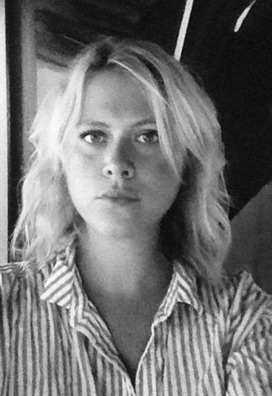
Aliénor Prouvost
Art Advisor
Multimedia
alienor@dianedepolignac.com

Mathilde Gubanski
Art Advisor
Gallery Manager
mathilde@dianedepolignac.com
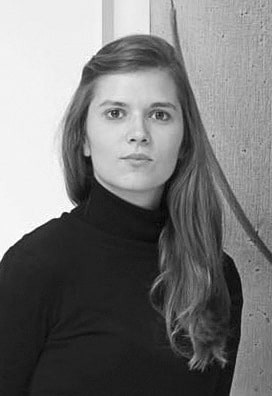
Astrid de Rendinger
Art Advisor
Publications Manager / Catalogues raisonnés
(Gérard Schneider / Loïs Frederick)
astrid@dianedepolignac.com
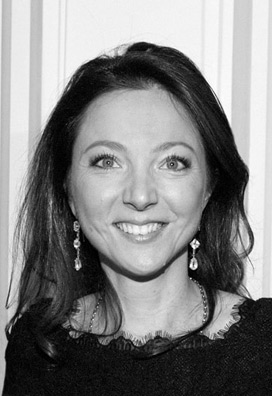
Diane de Polignac
Art Advisor
diane@dianedepolignac.com
